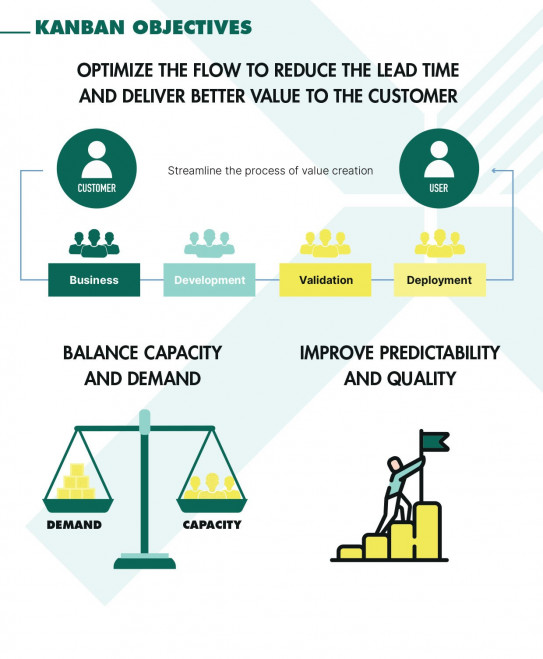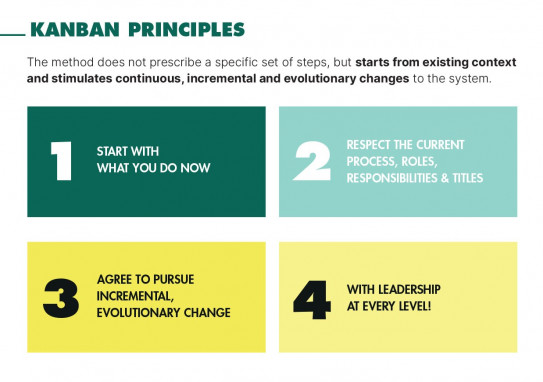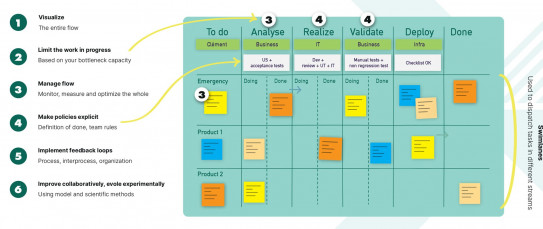
One day to get started with Kanban
The value of Kanban for workflow management continues to rise! As a result, it's no surprise that more and more businesses are embracing this strategy.
Based on my experience, I'd like to give an example of an activity you can use to introduce and launch a Kanban shift inside a team... With only one workshop day!
Icebreaker
To begin, I like to use an icebreaker / energizer to get things started on this type of day.
The first name game is one of my favorites for teams learning Kanban. It begins to introduce the limitations of multitasking and the benefits of restricting work-in-progress, in addition to making people active and moving (WIP).
Presentation of Lean, Kanban's origins, and its goals
After that, I give a quick overview of Kanban's history and roots, including Lean principles, before moving on to the core goals of Kanban, which are depicted in the diagram below.

At this point, we take a few minutes with the team to outline the goals that Kanban will help them reach. These goals must be SMART (specific, measurable, achievable, realistic (or relevant), and time-bound). These goals make Kanban implementation meaningful, and in a few months, we'll be able to assess benefits and identify areas for improvement.
A simulation is used to learn about Kanban's ideas and practices.
I prefer to use a simulation game to explore Kanban principles rather than presenting a theoretical talk. The Kanban Pizza Game is one that I frequently employ for these presentation and set-up days.
In under two hours, you may learn about and try out a variety of Kanban methods, such as workflow visualization, WIP limits, continuous improvement, feedback loops, and more.
An explanation of the game is available in both French and English.
A review of Kanban principles

I go over Kanban principles with the team I'm aiding in this step. It's an opportunity for me to clarify that we won't be changing their method of working right now; existing roles, responsibilities, and processes will be preserved. It will be their obligation, though, to make Kanban their own in order to improve their working methods.
A review of several Kanban approaches and a proposal for the team's setup
We look at the practices one by one once they've discovered them through the game to see how they may be applied to their specific field. Following a presentation of each, I assist the team in considering how it may be implemented in their setting.

A. Visualize the flow
I start by asking the group who they work for (their customers or users) and what service they offer. It's critical to comprehend the clients who make requests. After that, the team can figure out how requests get into the system. These individuals should, ideally, be involved in the Kanban setup process.
I next ask them to describe the processes associated with the various types of inquiries they deal with. We try our hardest at Kanban to create a global view of the value flow. We design the flow on the board step by step, all the way to value delivery. After that, we look at the columns in their Kanban board that can be useful.
The goal here is to establish a flow that will match the majority of the team's needs, not all of them.
B. Clearly state the management guidelines.
I ask the team to clarify who is working in each column and what the prerequisites are for moving on to the next column once the Kanban board's columns have been set. I continue to scribble on the whiteboard.
C. Limit work-in-progress
I then ask the team to put a few boundaries in its board without pressuring them to set ones that are excessively difficult. The goal is to gain a handle on Kanban. As the team continues to experiment with the method, it will be able to refine its limits. I'll use this chance to discuss the concepts of 'pull flow' and 'push flow' once more. The team should next add two sub-columns to each of its columns, labeled 'In Progress' and 'Complete.' Finally, we discuss emergencies, and the team decides how to handle them at first.
Other games, such as the Aeroplane Game, might help the team comprehend the benefits of adopting limitations if they still don't get it after playing the Kanban Pizza Game.
D. Manage the flow
We discuss the prospect of holding a daily meeting for flow management. I show the team how to have a daily Kanban meeting and ask if they want to use one in their setting. If this is the case, the team members decide on a time for the synchronization meeting.
E. Set up feedback loops.
At this point, we discuss what areas of the team would benefit from feedback loops:
- To its product: Would it be possible to host demonstrations of the new features? If so, who is it for? How frequently do you do it?
- To its work planning: How frequently would it want to handle request supply and priority, and how would it want to do so? Preset or event-based periodicity can be established (for example, we renew every two weeks) (e.g. we resupply when there are less than X requests left in our backlog). At a later date, the person(s) in charge will address supply and prioritization strategies in greater detail.
- To its performance: How frequently would it want to handle request supply and priority, and how would it want to do so? Preset or event-based periodicity can be established (for example, we renew every two weeks) (e.g. we resupply when there are less than X requests left in our backlog). At a later date, the person(s) in charge will address supply and prioritization strategies in greater detail.
F. Collaboratively improve and explore with new ideas
I discuss retrospectives in this article. While I attempt to assist them without pressuring them to make judgments in the other phases of setting up a Kanban, I do require that they plan an initial retrospective in this section. For the first several retrospectives, I also recommend that they set a frequency. This is because teams new to Kanban or Agile do not feel compelled to do retrospectives and do not develop the practice of doing so. So I'm going to go ahead and push them a little!
Other Kanban practices that are frequently utilized include:
- Classes of service: We'll look over the different types of requests the team handles to determine whether they can be turned into service classes;
- Corridors: I then demonstrate how corridors can be used, and the team chooses whether or not this is useful.
At the end of the day, the team understands what Kanban is and the benefits it can provide, and they've already begun working on their first Kanban. By the end of the day, the entire team is usually working on developing the Kanban board based on the decisions made throughout the day! It's critical to emphasize that this is only the start, that this is the team's Kanban, and that it's up to the team to own and grow it in order to get the most out of it.
Of course, the coach's assistance does not end there: we ask the teams what they expect from the coach. Furthermore, we recommend that you hold regular progress meetings with your team, and we offer to help with the first daily meetings and retrospectives, task prioritization and planning, metric use, and so on.
For this day, two key considerations must be kept in mind:
- The coach must provide the squad the ability to create their own Kanban. There's a good probability it won't deliver continual progress if the team doesn't own it. As a result, the coach will be present to facilitate, assist, and potentially advise and raise any concerns that demand caution.
- If the team is unfamiliar with agility or continuous development, it appears to me that the coach should work with them for a period of time to help them develop this mindset. When it comes to questioning practices and prospective adjustments, the same is true. Without guidance, the team's Kanban is unlikely to improve, and it will find itself confronting the same difficulties it did before a few months from now!
Based on my experience, I'd like to give an example of an activity you can use to introduce and launch a Kanban shift inside a team... With only one workshop day!
The photos in this article are from Kanban sheets that we generated and hand out at the conclusion of our Kanban training sessions and introductions. You may get them here: